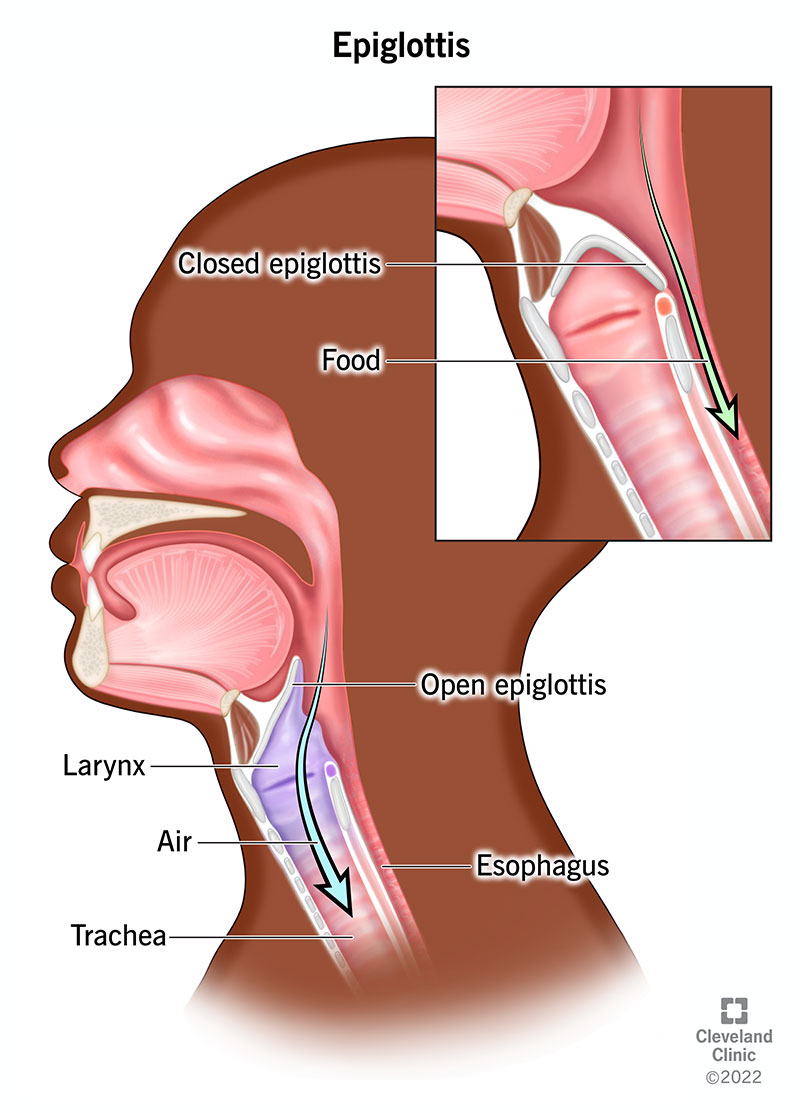Your epiglottis protects your ability to breathe by protecting your larynx (voice box). It keeps food and liquid from getting into your respiratory system. You can keep your epiglottis healthy by not smoking and protecting yourself from infection.
Advertisement
Cleveland Clinic is a non-profit academic medical center. Advertising on our site helps support our mission. We do not endorse non-Cleveland Clinic products or services. Policy

Your epiglottis is a small, leaf-shaped sheet of elastic cartilage that protects your larynx (voice box) and helps you swallow. Your larynx is a hollow tube that helps move air from your nose and mouth to your lungs. It’s located at the upper opening of your trachea (windpipe), which is the passageway to your lungs.
Advertisement
Cleveland Clinic is a non-profit academic medical center. Advertising on our site helps support our mission. We do not endorse non-Cleveland Clinic products or services. Policy
Your larynx is open at the top so air can move through it to your trachea. When you swallow, however, your epiglottis moves to cover the top of your larynx. Like a roadblock, your epiglottis prevents traffic (food and fluid) from using a specific road (your larynx) and moves traffic to another road (your esophagus).
When something affects your epiglottis, food and fluid that should go down your esophagus end up in your larynx. Your body reacts by making you cough so your larynx can dislodge the food and fluid (food and liquid in your larynx may also make you choke). More seriously, food or fluid in your larynx can move into your trachea and then into your lungs. This is aspiration, which can cause serious medical issues, such as pneumonia.
If you’re like most people, you swallow between 500 and 700 times a day, and your epiglottis goes into action with every swallow. When you swallow, the free end of your epiglottis flips backward to cover the opening of your larynx. When food or fluid gets close, the free end of your epiglottis flips up and pushes food or liquid away from your larynx toward your esophagus.
Healthcare providers believe several things happen to move your epiglottis into place when you swallow:
Advertisement
Your epiglottis is just behind your tongue, above and in front of your larynx. A combination of ligaments, muscles and mucous membrane anchor the base and sides of your epiglottis while leaving the top of your epiglottis loose and able to move. (Think of a tent with the back and sides tied down and the front flaps left untied so you can push them aside.)
Epiglottitis — when your epiglottis becomes swollen and inflamed — is the most common condition affecting your epiglottis. Most of the time, epiglottitis happens because you have an infection. Symptoms of epiglottitis caused by infections appear suddenly and get worse very quickly. Common epiglottitis symptoms include severe sore throat, pain when you swallow or difficulty swallowing.
Other things may make your epiglottis swell, such as drinking very hot liquids, being hit in your neck, smoking or chemical burns.
Depending on the cause, your epiglottis can swell so much that it blocks your larynx so you can’t get oxygen. Severe epiglottitis is a medical emergency that requires immediate medical attention so your body gets the oxygen it needs to function.
Sometimes, your epiglottis can become floppy or collapse. Normally, your epiglottis is upright unless it’s covering the top of your larynx. Floppy or collapsed epiglottis happens when your epiglottis “flops” over onto your glottis, affecting your ability to breathe. Some healthcare providers think floppy epiglottises contribute to obstructive sleep apnea syndrome.
Most of the time, people consult with a primary care physician if they have epiglottitis symptoms or feel as if they’re having trouble swallowing. A primary care physician may refer people to an otolaryngologist, a doctor who specializes in issues affecting your ears, nose and throat.
Yes, but it’s hard to say how often cancer affects people’s epiglottises. That’s because epiglottis cancer is one of several forms of laryngeal cancer. Your epiglottis is in the supraglottis section of your larynx. About 35% of laryngeal cancers start in your supraglottis.
Advertisement
Many things can damage your epiglottis so it can’t do its job. While you can’t avoid all of the circumstances that may damage your epiglottis, here are some suggestions on how to protect it:
There’s a reason — apart from good table manners — why you shouldn’t talk when your mouth is full of food. Every time you swallow your meal, your epiglottis moves to cover your larynx (windpipe) to keep food or liquid from getting into your larynx and possibly your lungs. Eating while talking increases the chance food or liquid will end up in your larynx, making you cough or choke as your larynx tries to dislodge food or liquid. Your epiglottis plays a big part in your respiratory health. You can take care of your epiglottis by stopping smoking and protecting yourself from infections that damage your epiglottis.
Advertisement
Cleveland Clinic’s primary care providers offer lifelong medical care. From sinus infections and high blood pressure to preventive screening, we’re here for you.

Last reviewed on 09/06/2022.
Learn more about the Health Library and our editorial process.